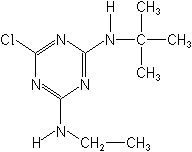Products >> Herbicides >> Terbuthylazine
Terbuthylazine 50%SC
Herbicide
HRAC C1 WSSA 5; 1,3,5-triazine

NOMENCLATURE
Common name terbuthylazine (BSI, E-ISO, (f) F-ISO, ANSI, WSSA)
IUPAC name N2-tert-butyl-6-chloro-N4-ethyl-1,3,5-triazine-2,4-diamine
Chemical Abstracts name 6-chloro-N-(1,1-dimethylethyl)-N'-ethyl-1,3,5-triazine-2,4-diamine
CAS RN [5915-41-3] EEC no. 227-637-9 Development codes GS 13 529
(Geigy)
Terbuthylazine APPLICATIONS
Biochemistry Photosynthetic electron transport inhibitor at the
photosystem II receptor site. Maize tolerance of triazines is attributed
to conjugation with glutathione. Mode of action Herbicide, absorbed
mainly by the roots. Uses Broad-spectrum pre- or post-emergence
weed control in maize, sorghum, vines, fruit trees, citrus, coffee,
oil palm, cocoa, olives, potatoes, peas, beans, sugar cane, rubber,
and in forestry in tree nurseries and new plantings. It remains
largely in the topsoil, controlling a wide range of weeds, at rates
of 0.6-3 kg a.i./ha; high rates are only recommended as band applications.
Phytotoxicity Phytotoxic to many annual plants and to aquatic plants.
Formulation types SC; WG. Selected tradenames: 'Folar' (Syngenta);
'Gardoprim' (Syngenta); 'Click' (Sipcam); 'Tyllanex' (Makhteshim-Agan);
mixtures: 'Topogard' (+ terbutryn) (Syngenta)
Terbuthylazine OTHER TRADENAMES
Mixtures: 'Gardoprim Plus' (+ metolachlor) (Syngenta); 'Lido' (+
pyridate) (Syngenta); 'Opogard' (+ terbutryn) (Syngenta); 'Alpha
Bromotril PT' (+ bromoxynil) (Makhteshim); 'Athado Invierno' (+
atrazine+ terbumeton) (Probelte); 'Athado Liquido' (+ terbumeton)
(Probelte); 'Athado Super' (+ glyphosate) (Probelte); 'Athado Verano'
(+ terbumeton+ terbutryn) (Probelte); 'Batallion' (+ terbutryn)
(Makhteshim-Agan); 'Gardobuc' (+ bromoxynil) (Syngenta, Aventis);
'RPA 04481H' (+ bromoxynil) (Aventis); 'Titer' (+ rimsulfuron) (Du
Pont); 'Wonder' (+ rimsulfuron) (Du Pont) Discontinued names: 'Primatol
M' * (Ciba-Geigy); 'Stentan' * (Ciba-Geigy) mixtures: 'Angle' *
(+ cyanazine) (Novartis); 'Bolero' * (+ diflufenican) (Novartis);
'Caragard' * (+ terbumeton) (Novartis); 'Primafit' * (+ pendimethalin)
(Novartis); 'Skirmish' * (+ isoxaben) (Novartis); 'Primatol 3588'
* (+ secbumeton) (Ciba-Geigy)
Terbuthylazine ANALYSIS
Product analysis by glc (CIPAC Handbook, 1983, 1B, 1897; AOAC Methods,
1995, 981.04, 971.08; FAO Specification (CP/61); J. Assoc. Off.
Anal. Chem., 1981, 64, 504); particulars available from Syngenta.
Residues determined by glc with DMC or FPD (K. Ramsteiner et al.,
ibid., 1974, 57, 192; Anal. Methods Pestic., Plant Growth Regul.
Food Addit., 1964, 4, 13).
MAMMALIAN TOXICOLOGY
Oral Acute oral LD50 for rats 1590->2000 mg/kg. Skin and eye
Acute percutaneous LD50 for rats >2000 mg/kg. No skin or eye
irritation. Not a skin sensitiser. Inhalation LC50 (4 h) for rats
>5.3 mg/l air. NOEL (1 y) for dogs 0.4 mg/kg b.w. daily; (lifetime)
for rats 0.22 mg/kg b.w. daily; (2 y) for mice 15.4 mg/kg b.w. daily.
ADI 0.0022 mg/kg. Water GV 7 mg/l (TDI 2.2 mg/kg b.w.). Toxicity
class WHO (a.i.) III (Table 5); EPA (formulation) III EC hazard
(R22)
ECOTOXICOLOGY
Birds Acute oral LD50 for ducks and quail >1000 mg/kg. Dietary
LC50 (8 d) for ducks and quail >5620 ppm. Fish LC50 (96 h) for
rainbow trout 3.8-4.6, bluegill sunfish 7.5, carp and catfish 7.0
mg/l. Daphnia LC50 (48 h) 21-50.9 mg/l. Algae EC50 (72 h) for Scenedesmus
subspicatus 0.016-0.024 mg/l. Bees LD50 (oral and contact) >100
mg/bee. Worms LC50 (7 d) for earthworms >200 mg/kg soil. Other
beneficial spp. No effects on bacterial respiration and nitrification
in range 10.9-109 mg/kg soil.
Terbuthylazine ENVIRONMENTAL FATE
Animals In mammals, following oral administration, 72-84% is eliminated
in the urine and faeces within 24 h, and almost all within 48 h.
A de-ethyl metabolite forms rapidly, followed by conjugates of products
formed by oxidation of one methyl group of the tert-butyl moiety.
All are rapidly excreted. Plants Triazine-tolerant plants (e.g.
maize) rapidly de-chlorinate terbuthylazine to hydroxy-terbuthylazine.
Various amounts of de-ethylated and hydroxy de-ethylated metabolites
are produced, depending on the plant species. Soil/Environment Adsorption
on soils is strong: Koc 162-278, Kd 2.2-25 are typical values for
light agricultural soils. Terbuthylazine is only slightly mobile.
Microbial degradation proceeds mainly by de-ethylation and hydroxylation,
with eventual ring cleavage. DT50 30-60 d in biologically active
soil.